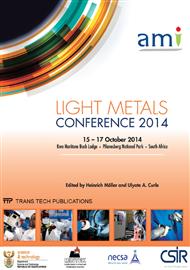p.61
p.67
p.74
p.81
p.90
p.96
p.103
p.112
p.120
Microstructure Evolution in Melt Conditioned Direct Chill (MC-DC) Casting of Fe-Rich Al-Alloy
Abstract:
In order to fabricate high quality aluminium products, it is first essential to produce high quality billets/slabs. One of the key objectives associated with casting processes is to be able to control the as-cast structure. A novel direct chill (DC) casting process, the melt conditioned direct chill (MC-DC) casting process, has been developed for production of high quality aluminium billets. In the MC-DC casting process, a high shear device is submerged in the sump of the DC mould to provide intensive melt shearing, which in turn, disperses potential nucleation particles, creates a macroscopic melt flow to uniformly distribute the dispersed particles, and maintains a uniform temperature and chemical composition throughout the melt in the sump. The effect of intensive shearing on the complex microstructure evolution observed after MC-DC is explained on the basis of nucleation and growth behavior. Complete suppression of typical columnar grain growth and significant equiaxed grain refinement is observed. The solidification mechanisms responsible for the significant grain refinement by intensive shearing and the morphological evolution of Mg2Si and Fe–containing intermetallic phases are discussed.
Info:
Periodical:
Pages:
90-95
Citation:
Online since:
October 2014
Authors:
Price:
Сopyright:
© 2014 Trans Tech Publications Ltd. All Rights Reserved
Share:
Citation:


